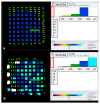A Multidisciplinary Evaluation of Three-Dimensional Polycaprolactone Bioactive Glass Scaffolds for Bone Tissue Engineering Purposes
- PMID: 38793481
- PMCID: PMC11122918
- DOI: 10.3390/ma17102413
A Multidisciplinary Evaluation of Three-Dimensional Polycaprolactone Bioactive Glass Scaffolds for Bone Tissue Engineering Purposes
Abstract
In the development of bone graft substitutes, a fundamental step is the use of scaffolds with adequate composition and architecture capable of providing support in regenerative processes both on the tissue scale, where adequate resistance to mechanical stress is required, as well as at the cellular level where compliant chemical-physical and mechanical properties can promote cellular activity. In this study, based on a previous optimization study of this group, the potential of a three-dimensional construct based on polycaprolactone (PCL) and a novel biocompatible Mg- and Sr-containing glass named BGMS10 was explored. Fourier-transform infrared spectroscopy and scanning electron microscopy showed the inclusion of BGMS10 in the scaffold structure. Mesenchymal stem cells cultured on both PCL and PCL-BGMS10 showed similar tendencies in terms of osteogenic differentiation; however, no significant differences were found between the two scaffold types. This circumstance can be explained via X-ray microtomography and atomic force microscopy analyses, which correlated the spatial distribution of the BGMS10 within the bulk with the elastic properties and topography at the cell scale. In conclusion, our study highlights the importance of multidisciplinary approaches to understand the relationship between design parameters, material properties, and cellular response in polymer composites, which is crucial for the development and design of scaffolds for bone regeneration.
Keywords: PCL; bioactive glasses; bone; composite scaffolds; human bone-marrow-derived mesenchymal stem cells; magnesium; therapeutic ions; tissue engineering.
Conflict of interest statement
Author Mauro Petretta was employed by the company REGENHU SA. The remaining authors declare that the research was conducted in the absence of any commercial or financial relationships that could be construed as a potential conflict of interest.
Figures














References
-
- Lee S.S., Du X., Kim I., Ferguson S.J. Scaffolds for Bone-Tissue Engineering. Matter. 2022;5:2722–2759. doi: 10.1016/j.matt.2022.06.003. - DOI
Grants and funding
LinkOut - more resources
Full Text Sources
Medical
Research Materials

